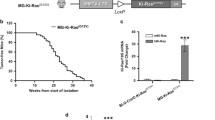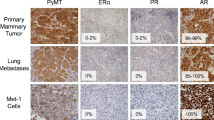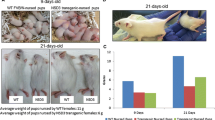Abstract
The C3(1) component of the rat prostate steroid binding protein has been used to target expression of the SV40 T/t-antigen to the mammary epithelium of mice resulting in pre-neoplastic lesions that progress to invasive and metastatic cancer with molecular features of human basal-type breast cancer. However, there are major differences in the histologic architecture of the stromal and epithelial elements between the mouse and human mammary glands. The rat mammary gland is more enriched with epithelial and stromal components than the mouse and more closely resembles the cellular composition of the human gland. Additionally, existing rat models of mammary cancer are typically estrogen receptor positive and hormone responsive, unlike most genetically engineered mouse mammary cancer models. In an attempt to develop a mammary cancer model that might more closely resemble the pathology of human breast cancer, we generated a novel C3(1)/SV40 T/t-antigen transgenic rat model that developed progressive mammary lesions leading to highly invasive adenocarcinomas. However, aggressive tumor development prevented the establishment of transgenic lines. Characterization of the tumors revealed that they were primarily estrogen receptor and progesterone receptor negative, and either her2/neu positive or negative, resembling human triple-negative or Her2 positive breast cancer. Tumors expressed the basal marker K14, as well as the luminal marker K18, and were negative for smooth muscle actin. The triple negative phenotype has not been previously reported in a rat mammary cancer model. Further development of a C3(1)SV40 T/t-antigen based model could establish valuable transgenic rat lines that develop basal-type mammary tumors.




Similar content being viewed by others
References
Ali SH, DeCaprio JA (2001) Cellular transformation by SV40 large T antigen: interaction with host proteins. Semin Cancer Biol 11:15–23
Anders C, Carey LA (2008) Understanding and treating triple-negative breast cancer. Oncology (Williston Park) 22:1233–1239 discussion 1239–1240, 1243
Banerjee S, Reis-Filho JS, Ashley S, Steele D, Ashworth A, Lakhani SR, Smith IE (2006) Basal-like breast carcinomas: clinical outcome and response to chemotherapy. J Clin Pathol 59:729–735
Barkan D, Montagna C, Ried T, Green JE (2004) Mammary gland cancer. In: Holland EC (ed) Mouse models of human cancer. Wiley, Hoboken, pp 103–131
Bennett CN, Green JE (2008) Unlocking the power of cross-species genomic analyses: identification of evolutionarily conserved breast cancer networks and validation of preclinical models. Breast Cancer Res 10:213
Bertucci F, Finetti P, Cervera N, Esterni B, Hermitte F, Viens P, Birnbaum D (2008) How basal are triple-negative breast cancers? Int J Cancer 123:236–240
Cardiff R (2001) Validity of mouse mammary tumour models for human breast cancer: comparative pathology. Microsc Res Tech 52:224–230
Cardiff RD, Wellings SR (1999) The comparative pathology of human and mouse mammary glands. J Mammary Gland Biol Neoplasia 4:105–122
CDC (2009) US Cancer Statistics Working Group. United States Cancer Statistics: 1999–2005 Incidence and Mortality Web-based Report. D. N. C. I. Department of Health and Human Services (ed), Washington
Chomczynski P, Sacchi N (2006) The single-step method of RNA isolation by acid guanidinium thiocyanate-phenol-chloroform extraction: twenty-something years on. Nat Protoc 1:581–585
Dabbs DJ, Chivukula M, Carter G, Bhargava R (2006) Basal phenotype of ductal carcinoma in situ: recognition and immunohistologic profile. Mod Pathol 19:1506–1511
Deeb KK, Michalowska AM, Yoon CY, Krummey SM, Hoenerhoff MJ, Kavanaugh C, Li MC, Demayo FJ, Linnoila I, Deng CX, Lee EY, Medina D, Shih JH, Green JE (2007) Identification of an integrated SV40 T/t-antigen cancer signature in aggressive human breast, prostate, and lung carcinomas with poor prognosis. Cancer Res 67:8065–8080
Doane AS, Danso M, Lal P, Donaton M, Zhang L, Hudis C, Gerald WL (2006) An estrogen receptor-negative breast cancer subset characterized by a hormonally regulated transcriptional program and response to androgen. Oncogene 25:3994–4008
Dundas SR, Ormerod MG, Gusterson BA, O’Hare MJ (1991) Characterization of luminal and basal cells flow-sorted from the adult rat mammary parenchyma. J Cell Sci 100(Pt 3):459–471
Ellis IO, Galea M, Broughton N, Locker A, Blamey RW, Elston CW (1992) Pathological prognostic factors in breast cancer. II. Histological type. Relationship with survival in a large study with long-term follow-up. Histopathology 20:479–489
Elston CW, Ellis IO (2002) Pathological prognostic factors in breast cancer. I. The value of histological grade in breast cancer: experience from a large study with long-term follow-up. Histopathology 41:154–161
Green ES, Menz MD, LaVail MM, Flannery JG (2000a) Characterization of rhodopsin mis-sorting and constitutive activation in a transgenic rat model of retinitis pigmentosa. Invest Ophthalmol Vis Sci 41:1546–1553
Green JE, Shibata MA, Yoshidome K, Liu ML, Jorcyk C, Anver MR, Wigginton J, Wiltrout R, Shibata E, Kaczmarczyk S, Wang W, Liu ZY, Calvo A, Couldrey C (2000b) The C3(1)/SV40 T-antigen transgenic mouse model of mammary cancer: ductal epithelial cell targeting with multistage progression to carcinoma. Oncogene 19:1020–1027
Green JE, Shibata MA, Shibata E, Moon RC, Anver MR, Kelloff G, Lubet R (2001) 2-difluoromethylornithine and dehydroepiandrosterone inhibit mammary tumor progression but not mammary or prostate tumor initiation in C3(1)/SV40 T/t-antigen transgenic mice. Cancer Res 61:7449–7455
Gusterson B (2009) Do ‘basal-like’ breast cancers really exist? Nat Rev Cancer 9:128–134
Gusterson BA, Ross DT, Heath VJ, Stein T (2005) Basal cytokeratins and their relationship to the cellular origin and functional classification of breast cancer. Breast Cancer Res 7:143–148
Herschkowitz JI, Simin K, Weigman VJ, Mikaelian I, Usary J, Hu Z, Rasmussen KE, Jones LP, Assefnia S, Chandrasekharan S, Backlund MG, Yin Y, Khramtsov AI, Bastein R, Quackenbush J, Glazer RI, Brown PH, Green JE, Kopelovich L, Furth PA, Palazzo JP, Olopade OI, Bernard PS, Churchill GA, Van Dyke T, Perou CM (2007) Identification of conserved gene expression features between murine mammary carcinoma models and human breast tumors. Genome Biol 8:R76
Herschkowitz JI, He X, Fan C, Perou CM (2008) The functional loss of the retinoblastoma tumour suppressor is a common event in basal-like and luminal B breast carcinomas. Breast Cancer Res 10:R75
Horner MJ, Ries LAG, Krapcho M, Neyman N, Aminou R, Howlader N, Altekruse SF, Feuer EJ, Huang L, Mariotto A, Miller BA, Lewis DR, Eisner MP, Stinchcomb DG, Edwards BK (2009) SEER cancer statistics review, 1975–2006. National Cancer Institute, Bethesda
Kavanaugh C, Green JE (2003) The use of genetically altered mice for breast cancer prevention studies. J Nutr 133:2404S–2409S
Kavanaugh CJ, Desai KV, Calvo A, Brown PH, Couldrey C, Lubet R, Green JE (2002) Pre-clinical applications of transgenic mouse mammary cancer models. Transgenic Res 11:617–633
Kitagawa K, Sakuma H, Ishida N, Hirano T, Ishihara A, Takeda K (2004) Contrast-enhanced high-resolution MRI of invasive breast cancer: correlation with histopathologic subtypes. AJR Am J Roentgenol 183:1805–1809
Lerma E, Peiro G, Ramon T, Fernandez S, Martinez D, Pons C, Munoz F, Sabate JM, Alonso C, Ojeda B, Prat J, Barnadas A (2007) Immunohistochemical heterogeneity of breast carcinomas negative for estrogen receptors, progesterone receptors and Her2/neu (basal-like breast carcinomas). Mod Pathol 20:1200–1207
Livasy CA, Karaca G, Nanda R, Tretiakova MS, Olopade OI, Moore DT, Perou CM (2006) Phenotypic evaluation of the basal-like subtype of invasive breast carcinoma. Mod Pathol 19:264–271
Ludlow JW (1993) Interactions between SV40 large-tumor antigen and the growth suppressor proteins pRB and p53. Faseb J 7:866–871
Maroulakou IG, Anver M, Garrett L, Green JE (1994) Prostate and mammary adenocarcinoma in transgenic mice carrying a rat C3(1) simian virus 40 large tumor antigen fusion gene. Proc Natl Acad Sci USA 91:11236–11240
Nandi S, Guzman RC, Yang J (1995) Hormones and mammary carcinogenesis in mice, rats, and humans: a unifying hypothesis. Proc Natl Acad Sci USA 92:3650–3657
Nielsen NH, Emdin SO, Cajander J, Landberg G (1997) Deregulation of cyclin E and D1 in breast cancer is associated with inactivation of the retinoblastoma protein. Oncogene 14:295–304
Nielsen TO, Hsu FD, Jensen K, Cheang M, Karaca G, Hu Z, Hernandez-Boussard T, Livasy C, Cowan D, Dressler L, Akslen LA, Ragaz J, Gown AM, Gilks CB, van de Rijn M, Perou CM (2004) Immunohistochemical and clinical characterization of the basal-like subtype of invasive breast carcinoma. Clin Cancer Res 10:5367–5374
Nozoe T, Oyama T, Mori E, Uramoto H, Takenoyama M, Hanagiri T, Sugio K, Yasumoto K (2007) Clinicopathologic significance of an immunohistochemical expression of p27 in scirrhous carcinoma of the breast. Breast Cancer 14:277–280
Ottewell PD, Coleman RE, Holen I (2006) From genetic abnormality to metastases: murine models of breast cancer and their use in the development of anticancer therapies. Breast Cancer Res Treat 96:101–113
Perou CM, Jeffrey SS, van de Rijn M, Rees CA, Eisen MB, Ross DT, Pergamenschikov A, Williams CF, Zhu SX, Lee JC, Lashkari D, Shalon D, Brown PO, Botstein D (1999) Distinctive gene expression patterns in human mammary epithelial cells and breast cancers. Proc Natl Acad Sci USA 96:9212–9217
Perou CM, Sorlie T, Eisen MB, van de Rijn M, Jeffrey SS, Rees CA, Pollack JR, Ross DT, Johnsen H, Akslen LA, Fluge O, Pergamenschikov A, Williams C, Zhu SX, Lonning PE, Borresen-Dale AL, Brown PO, Botstein D (2000) Molecular portraits of human breast tumours. Nature 406:747–752
Rakha EA, Reis-Filho JS, Ellis IO (2008) Basal-like breast cancer: a critical review. J Clin Oncol 26:2568–2581
Reis-Filho JS, Tutt AN (2008) Triple negative tumours: a critical review. Histopathology 52:108–118
Ribeiro-Silva A, Ramalho LN, Garcia SB, Brandao DF, Chahud F, Zucoloto S (2005) p63 correlates with both BRCA1 and cytokeratin 5 in invasive breast carcinomas: further evidence for the pathogenesis of the basal phenotype of breast cancer. Histopathology 47:458–466
Russo J, Tay LK, Ciocca DR, Russo IH (1983) Molecular and cellular basis of the mammary gland susceptibility to carcinogenesis. Environ Health Perspect 49:185–199
Russo J, Russo IH, Rogers AE, van Zwieten MJ, Gusterson B (1990) Pathology of tumours in laboratory animals. Tumours of the rat. Tumours of the mammary gland. IARC Sci Publ 47–78
Sasaki Y, Tsuda H (2009) Clinicopathological characteristics of triple-negative breast cancers. Breast Cancer 16:254–259
Shibata MA, Jorcyk CL, Liu ML, Yoshidome K, Gold LG, Green JE (1998) The C3(1)/SV40 T antigen transgenic mouse model of prostate and mammary cancer. Toxicol Pathol 26:177–182
Skoog L, Humla S, Axelsson M, Frost M, Norman A, Nordenskjold B, Wallgren A (1987) Estrogen receptor levels and survival of breast cancer patients. A study on patients participating in randomized trials of adjuvant therapy. Acta Oncol 26:95–100
Smits BM, Cotroneo MS, Haag JD, Gould MN (2007) Genetically engineered rat models for breast cancer. Breast Dis 28:53–61
Sorlie T, Perou CM, Tibshirani R, Aas T, Geisler S, Johnsen H, Hastie T, Eisen MB, van de Rijn M, Jeffrey SS, Thorsen T, Quist H, Matese JC, Brown PO, Botstein D, Eystein Lonning P, Borresen-Dale AL (2001) Gene expression patterns of breast carcinomas distinguish tumor subclasses with clinical implications. Proc Natl Acad Sci USA 98:10869–10874
Sorlie T, Tibshirani R, Parker J, Hastie T, Marron JS, Nobel A, Deng S, Johnsen H, Pesich R, Geisler S, Demeter J, Perou CM, Lonning PE, Brown PO, Borresen-Dale AL, Botstein D (2003) Repeated observation of breast tumor subtypes in independent gene expression data sets. Proc Natl Acad Sci USA 100:8418–8423
Thike AA, Cheok PY, Jara-Lazaro AR, Tan B, Tan P, Tan PH (2010) Triple-negative breast cancer: clinicopathological characteristics and relationship with basal-like breast cancer. Mod Pathol 23:123–133
Troester MA, Herschkowitz JI, Oh DS, He X, Hoadley KA, Barbier CS, Perou CM (2006) Gene expression patterns associated with p53 status in breast cancer. BMC Cancer 6:276
Van Dyke T, Jacks T (2002) Cancer modeling in the modern era: progress and challenges. Cell 108:135–144
Wang B, Kennan WS, Yasukawa-Barnes J, Lindstrom MJ, Gould MN (1991) Frequent induction of mammary carcinomas following neu oncogene transfer into in situ mammary epithelial cells of susceptible and resistant rat strains. Cancer Res 51:5649–5654
Weigelt B, Reis-Filho JS (2009) Histological and molecular types of breast cancer: is there a unifying taxonomy? Nat Rev Clin Oncol 6:718–730
Wu K, Kim HT, Rodriquez JL, Munoz-Medellin D, Mohsin SK, Hilsenbeck SG, Lamph WW, Gottardis MM, Shirley MA, Kuhn JG, Green JE, Brown PH (2000) 9-cis-Retinoic acid suppresses mammary tumorigenesis in C3(1)-simian virus 40 T antigen-transgenic mice. Clin Cancer Res 6:3696–3704
Xu X, Wagner KU, Larson D, Weaver Z, Li C, Ried T, Hennighausen L, Wynshaw-Boris A, Deng CX (1999) Conditional mutation of Brca1 in mammary epithelial cells results in blunted ductal morphogenesis and tumour formation. Nat Genet 22:37–43
Yoshidome K, Shibata MA, Maroulakou IG, Liu ML, Jorcyk CL, Gold LG, Welch VN, Green JE (1998) Genetic alterations in the development of mammary and prostate cancer in the C3(1)/Tag transgenic mouse model. Int J Oncol 12:449–453
Acknowledgments
This research was supported in part by the Intramural Research Program of the NIH, National Cancer Institute. We are grateful to Ron Lubet (NCI) and Clinton Grubbs (University of Alabama-Birmingham) for their assistance in providing control samples for immunohistochemistry, and Donna Bucher at PHL (NCI-Frederick) for technical assistance. We would like to thank Jerry Ward (Global Vet Pathology) for helpful discussions.
Author information
Authors and Affiliations
Corresponding author
Additional information
M. J. Hoenerhoff, and M. A. Shibata contributed equally to this work.
Rights and permissions
About this article
Cite this article
Hoenerhoff, M.J., Shibata, M.A., Bode, A. et al. Pathologic progression of mammary carcinomas in a C3(1)/SV40 T/t-antigen transgenic rat model of human triple-negative and Her2-positive breast cancer. Transgenic Res 20, 247–259 (2011). https://doi.org/10.1007/s11248-010-9406-5
Received:
Accepted:
Published:
Issue Date:
DOI: https://doi.org/10.1007/s11248-010-9406-5




